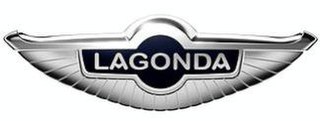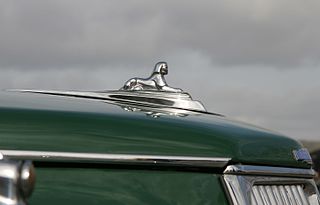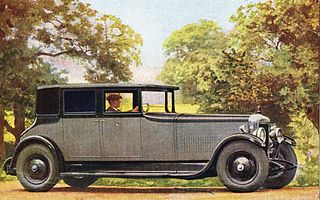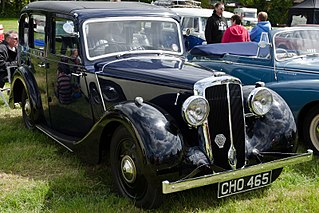
Lagonda is a British luxury car brand established in 1906, which has been owned by Aston Martin since 1947. The trade-name has not had a continuous commercial existence, being dormant several times, most recently from 1995 to 2008 and 2010 to 2013.

The Armstrong Siddeley Sapphire is a large automobile which was produced by the British company, Armstrong Siddeley Motors Limited, from 1952 to 1960.

The Bentley Mark VI is an automobile from Bentley which was produced from 1946 until 1952.
The MG K-type Magnette is a motor car produced in the United Kingdom by MG from October 1932 to 1934.

Dante Giacosa was an Italian automobile designer and engineer responsible for a range of Italian automobile designs — and for refining the front-wheel drive layout to an industry-standard configuration.

The Riley Nine was one of the most successful light sporting cars produced by the British motor industry in the inter war period. It was made by the Riley company of Coventry, England with a wide range of body styles between 1926 and 1938.

The Fiat 518, also called Fiat Ardita, was a model of car produced by Italian car manufacturer Fiat between 1933 and 1938. The name "Ardita" was also used on the six-cylinder engined and more expensive Fiat Ardita 2500 or 527.
The Rover 8 was a small single-cylinder 8 hp 1327 cc car made by the British Rover car company. It was Rover's first production car. It was remarkable for being supported by a backbone chassis rather than a conventional ladder frame. The first model was manufactured from 1904 to 1912. A Daimler-Knight sleeve valve engine option was available on the original model in 1911 and 1912.

The Rover 10 was a small family car from the British Rover car company produced between 1927 and 1947.

The Wolseley Hornet is a six-cylinder twelve fiscal horsepower lightweight automobile which was offered as a saloon car, coupé and open two-seater as well as the usual rolling chassis for bespoke coachwork. Produced by Wolseley Motors Limited from 1930 until 1936, the Hornet was unveiled to the public at the end of April 1930. Wolseley had been bought from the receivers by William Morris in 1927.

The Triumph Renown is strictly the name given to the Triumph's large saloon car made from 1949 to 1954 but it is, in reality, part of a three-car series of the 1800, 2000 and Renown models. Together with the Triumph Roadster, they were the first vehicles to carry the Triumph badge following the company's takeover by the Standard Motor Company.

The Rover 12 was a name given to several medium-sized family cars from the British Rover car company between 1905 and 1948.

The Alvis Speed 20 is a British touring car that was made between late 1931 and 1936 by Alvis Car and Engineering Company in Coventry. It went through four variants coded SA to SD.

The Alvis 12/50 is a car introduced by British business Alvis Car and Engineering Company Ltd in 1923. It went through a series of versions, with the last ones being made in 1932. A range of factory bodies could be specified in two- or four-seat form, with either open or closed bodies.

Daimler Double-Six piston engine was a sleeve-valve V12 engine manufactured by The Daimler Company Limited of Coventry, England between 1926 and 1938 in four different sizes for their flagship cars.

The Lanchester Eighteen at first known as the 15/18 was announced at the beginning of October 1931. Quite unlike any previous Lanchester it was their first new car following BSA's takeover of The Lanchester Motor Company Limited in January 1931. A medium sized car was a new departure for Lanchester.

The Lanchester Fourteen Roadrider is a six-cylinder automobile introduced by the Lanchester Motor Company in the beginning of September 1936. It was named "Roadrider" for its special suspension features, and billed as the lowest-priced six-cylinder Lanchester ever offered. This car replaced the previous 12 hp Light Six model with a larger six-cylinder engine again in the Lanchester Eleven chassis and body.

The Vauxhall 20-60 is a four or five-seater saloon, limousine, tourer or coupé-cabriolet manufactured by Vauxhall of Luton. It was announced on 28 September 1927 with a six-cylinder engine and a four-speed gearbox. A cautious move downmarket. "The first time any six-cylinder Vauxhall has been sold under £1000!" "British & Vauxhall". The initial 2.7-litre engine was enlarged to 3-litres after twelve months.

The Lagonda LG6 is a large car produced by the British Lagonda company from 1937 until 1940. It was announced at the 1937 London Motor Show.

The Lagonda 14/60 was a sports touring car introduced by Lagonda in 1925. Production of the 14/60 continued until 1931. As well as the standard car there were variants called the 2 Litre Speed (1927–33) and Continental.


















